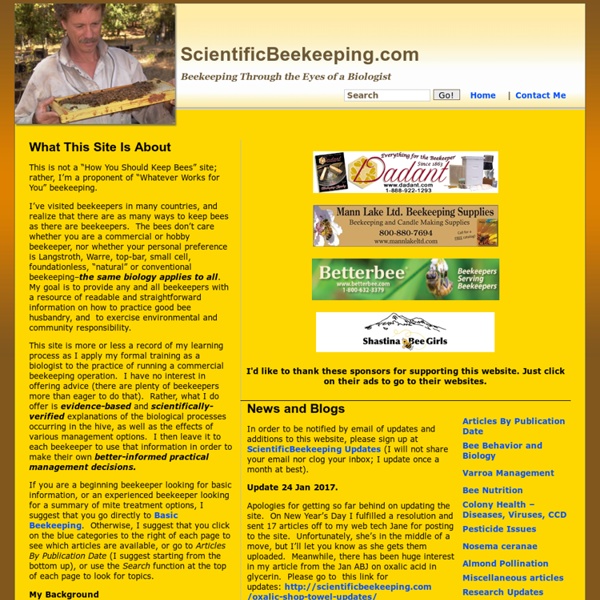



West Wales Bee Breeding Program First Year Care For Your Nuc @ Scientific Beekeeping Updated May 9, 2015. I continually update this page, so please refer to the current version. For mite treatment options, scroll down. This page provides some quick step-by-step notes for your first year of beekeeping, written specifically for those starting with a nucleus hive or package bees purchased from me, but generally applicable. First, educate yourself! It is more difficult to keep healthy bees than it is to care for a pet (for which you generally need only to provide food). There are several good beginners books. First Lessons in Beekeeping, Dadant. The Beekeeper’s Handbook by Diana Sammataro & Alfonse Avitabile. Beekeeping for Dummies. Honey Bee Hobbyist by Norm Gary—good overall understanding, rather than how-to. Homegrown Honey Bees by Alethea Morrison. Great beginners book free download: A Book of Bees, Sue Hubble–beautiful prose about being a beekeeper And of course, ScientificBeekeeping.com. The Rules Q: What “should I do?” Notes:
Queen bees An isolation mating programme was set up for the production of queens during 2005 enabling Queens to be available for sale in limited numbers. These bees are good tempered and as they are the native bee in the UK, are best suited to our climate. They fly in cooler conditions and over winter well. Far superior to the poor quality imported bees, or bad tempered cross-breeds! Beekeepers please call if you are interested in buying queens, or if you want to join our queen rearing group. Queens fully booked for 2010, as we are supplying local beekeepers to improve local bees. Honey Date and Nut Cake This cake has a craggy broken top. Our bees have been busy. Contact:Geoff Critchley15 Lon Cilan, Cilcain, Mold, CH7 5PL.Tel: 01352 740991.E-mail:Geoff@HoneyHouse.biz Click on the photo for a larger image.
Diary of a novice bee-keeper FAQ 2 About Honey Bees: All the sort of things you might be interested in as a non-beekeeper. I wrote this FAQ before I'd ever heard of FAQ's and I called it 'Common Questions about Honey Bees'. When collecting swarms I would chat to the panicking 'victims' and generally win them around to being interested in the life of the honey bee. This was OK but I soon realised that people were often asking the same questions and sometimes I didn't have time to give the whole answer. Eventually I got around to writing down all the answers to the typical questions asked.
www.montybees.org.uk British Bee Keepers Association endorses Bayer pesticides January 10 2011 Since 2001, the British Bee Keepers Association has been receiving in the region of £17,500 per annum from pesticide manufacturers Bayer, Syngenta, BASF and Belchim in return for the BBKA's endorsement of several insecticides as 'bee-friendly'. The BBKA policy of accepting money from such corporations, taken without consulting the membership, has been condemned by many of its members, other European bee keeping associations and some NGOs as unethical. While the Executive have now changed their mind again and claim to be about to drop the direct endorsement of pesticides, they have not ruled out accepting money from pesticide manufacturers under other pretexts. And there are still some very important questions that remain unanswered. We call on the BBKA to sever all financial ties to manufacturers, sellers and promoters of any substance known to be or likely to be toxic to bees or other insects. Philip Chandler, Friends of the Bees Dr. This letter is supported by: Yours
Oswestry Beekeepers Association Welcome to Standing as it does in the Marches, between the Welsh mountains and the meres of the North Shropshire plain, the market town of Oswestry has a violent history which can be traced from prehistoric times with the iron age fort 'Old Oswestry' (ca. 550 B.C.), through Roman marching camps, pagan-Christian battlefields (A.D. 642 - the pagans won), and frequent sackings by both the Welsh and the Normans between 1215 and 1400. Nowadays things are quieter except for the occasional road rage on the A5, Telford's London-Holyhead road. Bees around Oswestry may lack the abundant bee forage available in some other parts of the country, but there is usually a crop to be had from dandelion in the spring, and perhaps field beans later on, then heather honey for those adventurous enough to move their bees up into the mountains in late summer. And there is Oil-seed Rape.
LESSON 56: COMMONLY ASKED QUESTIONS Hello From Long Lane Honey Bee Farms! We are David & Sheri Burns and we are passionate about beekeeping. We started out keeping bees as a hobby and the hobby went wild. For us, beekeeping is a blast. If you are considering becoming a beekeeper next year, then now is the time to prepare. So, my nose is glue in books every spare moment I have. We've added two new features to our web presence: LESSON 56: COMMON QUESTIONS ADDRESSED We receive so many questions from beekeepers around the world. And I've just thrown in random beekeeping pictures for your enjoyment. Q... A... Q... A... Q...Good afternoon, Mr. A... Q... A... Q... A... Q... Thanks so much for your time,Nadina A... Q... A... Q... But basically, wait until the warmest day possible, maybe upper 30s or 40s (f) or 50s is better, and just briefly open up the hive to peek and make sure there is plenty of stored honey next to the cluster. Q... A... Q...Hello David, I have really enjoyed your beekeeping lessons online. 1. 2. Tim
Sustainable Beekeeping Introduction Robin Morris - Bar, top, and sustainable